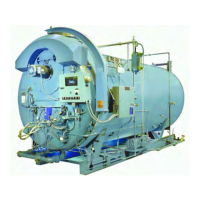Chapter 8 — Inspection and Maintenance
Part No. 750-184 8-11
J. SOLENOID VALVES
Foreign matter between the valve seat and seat disc can cause leakage.
Valves are readily disassembled; however, care must be used during
disassembly to be sure that internal parts are not damaged during the
removal and that reassembly is in proper order.
A low hum or buzzing will normally be audible when the coil is energized. If
the valve develops a loud buzzing or chattering noise, check for proper
voltage and clean the plunger assembly and interior plunger tube thoroughly.
Do not use any oil. Be sure that the plunger tube and solenoid are tight when
reassembled. Take care not to nick, dent, or damage the plunger tube.
Coils may be replaced without removing the valve from the line.
Be sure to turn off power to the valve in order to avoid
electrical shock. Failure to follow these instructions could
result in serious personal injury or death.
Check coil position and make sure that any insulating washers or retaining
springs are reinstalled in proper order.
K. AIR CONTROL DAMPER, LINKAGE AND CAM
SPRING
The burner air control damper should be checked for free movement as a
part of the monthly inspection. With the burner off and the jackshaft damper
control rod disconnected, the air control damper should rotate freely through
its entire range of movement. Any resistance to movement or excessive play
in the support bearing should be investigated and corrected before the
burner is put back in operation.
The overall tightness of the linkage assembly should be checked monthly. If
necessary, tighten the setscrews and the connections at the uniballs. Check
the uniballs for wear and replace if necessary.
The linkage assembly should be tight but should not bind. If the linkage
assembly is binding, determine the cause of the binding and correct as
necessary.
Linkage rod end attachment points should be marked on the variable
displacement linkage arms as an aid in subsequent reassembly.
Inspection of the air damper and linkage bearings should be performed on a
more frequent basis if the boiler is operating in a dirty environment.
The fuel cam profile spring should be inspected monthly for wear, scoring or
distortion. If any of the questionable conditions are found, the spring must
be replaced immediately to avoid the possibility of breakage in service. Use
care to avoid damaging the cam or spring during installation.
Lubricate occasionally with a non-gumming, dripless, high-temperature
lubricant such as graphite or a silicone derivative.
Combustion should be checked and readjusted as required
whenever the burner is removed or any control linkage is

